| In May 2015, Tanks & Tablecloths: Chapter Two explored the extensive archives of Devonport Naval Heritage Centre (DNHC), relocating original artefacts and presenting these alongside new works in the gallery of Plymouth Arts Centre.The exhibition was a test-ground for our experimental concept of ‘an exploded book’: an attempt to define how a work might be ‘read’ in space, using four-dimensional interrelationships between text, subject and object. DNHC holds a fascinating military collection which records the development of the dockyard and Plymouth’s role in the Royal Navy. It houses a large collection of ‘victualling’ artefacts from the Royal William Yard in Stonehouse. This vast facility, designed by Sir John Rennie and completed in 1831, became the major provisioning, or ‘victualling’, depot of the Royal Navy. Buildings in the Yard included a Cooperage, Slaughterhouse and Brewhouse (although the latter was never used for this purpose). Supplies for the Royal Navy were stored at the Yard, including equipment, food rations and clothing. From our first visits to DNHC, we were struck by the quantity of items that established consistency, systematization and uniformity: from mess utensils regulating portion sizes, to photographs documenting damage to ships from enemy fire. In response, the curation of artefacts and new works is framed by these notions of measuring, quantifying, delineating and assessing, symbolised in the exhibition by the ancient Greek myth of the Fates, or Moirai. These three female deities were charged with spinning, measuring and cutting the thread of life. The exhibition was organised within these jurisdictions: Clotho, the Spinner; Lachesis, the Allotter and Atropos, the Unturning. Through a process of reduction – both literal and semantic – we interrogated the materials, processes and words used in the responsive works, paring down to their essential properties or etymology. Belli Dura Despicio [Broadside] considers the multiple meaning of the word ‘broadside’, as a description of a position, an action, a measurement and a print-term. In its complete edition of 150, Belli Dura Despicio [Broadside] depicts the 29.7km broadside range of HMS Warspite. While making the film Quercus Regius: 00:58-01:29 in the darkroom, the artists assumed the roles of the Fates, blindly unravelling, measuring and cutting thread on to light-sensitive film, the animated duration of which corresponds to that of the sinking of HMS Royal Oak (both warships were built in Devonport). The Measure of a Man series of works took the concept of the ‘average man’ to develop a series of unconventional metrics for describing the human body. The wool from a standard ex-Government naval jumper was re-spun into rope (referencing Devonport’s historic ropery); the amount of salt present in the average male was extracted using a process of rapid evaporation from seawater gathered in Plymouth Sound. The process of making the works and the time invested in their creation was as important as the finished pieces themselves, and the passage of time made visible in some of the works designed to tarnish and corrode during the period of the exhibition. Each section of the exhibition was demarcated by a specially created 'treadplate', depicting the name of the deities, referencing the ship's treadplates in the DNHC collection. This exhibition was a rare opportunity to see the archive items outside of the DNHC, where pre-booking is required. For further details on DNHC open days and booking details, visit www.devonportnhc.wordpress.com Credits and thanks For their generous support in terms of time, equipment, knowledge and expertise: Nicola Dowding and Ray Crockett at Devonport Naval Heritage Centre for their generosity in allowing us full access to the DNHC archive; all the volunteers at Devonport Naval Heritage Centre but particularly Keith Johnson, Paul Santillo, Bob Cook and David Boden for their time and helpful insights into archive items; Drummond Masterton for CNC milling of Clotho, Lachesis and Atropos; Paul Ridout for all his work editing and sequencing Quercus Regius: 00:58-01:29; Jean Fenton at Kaeravel Krafts for her expertise in all things wool and for spinning our thread ready for rope-making; Tessa Wannell and staff at Morwhellham Quay for helping us make the rope; Oliver Udy at Plymouth University for his help in the darkroom; Vickie Fear, Caroline Mawdsley, Steve Mitchell and Ben Borthwick at Plymouth Arts Centre for their help in producing this show; Tim Mills at Plymouth History Festival for first putting us in contact with DNHC; Cornwall Ladies Auxilliary (West) for knot-tying; South West Film & Television Archive for loan of film equipment; Peninsula Arts for loan of plinths and Estates at Plymouth University for plinth porterage; Owen Ryles for his introduction to Plymouth Athenaeum; James Jobling-Purser and Gus Williams at Holman’s Test Mine, University of Exeter for explosives advice. Finally we would both like to thank our ever-patient and supportive families. All artefacts on loan from Devonport Naval Heritage Centre. Archive images courtesy of Devonport Naval Heritage Centre. Photos by Andy Ford |

 Fig. i
Fig. iCombed Tops Date unknown Samples of wool ‘tops’ used for spinning yarn 783 x 385 x 55 mm 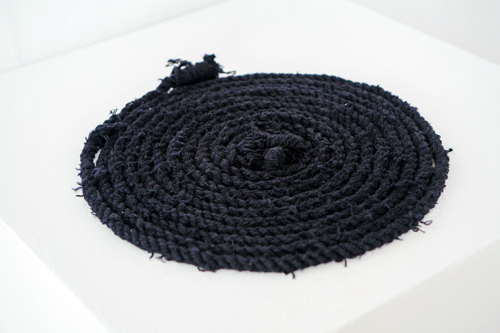 Fig. ii
Fig. iiThe Measure of a Man I [4 Fathoms] Wool from one disassembled navy surplus pullover, spun into rope 7320 x 20 mm 
 Fig. iii
Fig. iiiItalian Torpedo I, II 1943 Digital reproductions of original archive print and glass negative 229 x 173 mm Fig. iv Helios Ball of wool taken from naval jumper & 35mm orthographic film 9400 x 35 mm wound film & approximately 50000 x 1 mm wound wool 


Fig. v The Measure of a Man II [For Herbert] Electroformed copper feather, equivalent weight of coal grains on folded handkerchief 130 x 20 mm & 130 x 130 mm  Fig. vi Things That Were / Things That Are / Things That Are To Be CNC Engraved Traffolyte 125/120/150 x 40 x 2.5 mm  Fig. vii Lead footprint Believed to be 1940 but no accurate records 295 x 385 x 10 mm From a diver’s suit: 'The weighted sole is bolted to a wooden insole, which in turn has a leather, canvas or rubber upper. Lead was the most common sole and a pair could weigh up to 34 lb.' [Source: Wikipedia]  Fig. viii Uncurling machine Date of original artefact and origin unknown Digital reproduction of original archive item Print size 274 x 302 mm “Hand uncurling machine used at Royal Clarence Yard [Gosport] for untwisting hair to make mattresses.” [Source: DNHC]  Fig. ix Clotho (The Spinner) CNC milled aluminium sheet 765 x 355 x 10 mm |
 Fig. x HMS Ashanti, damage to bow I, II, III 1944 Digital prints from original glass negative 227 x 167 mm  Fig. xi Ex HMS Belfast, damaged copper tanks I, II Date unknown Digital prints from original glass negative 230 x 173 mm  Fig. xii The Measure of a Man III [Worth His Salt/Test His Mettle] Plymouth Sound sea salt on brass 600 x 600 x 2 mm CZ108 brass sheet; 350g of salt made from Plymouth Sound seawater  Fig. xiii Brass measures 1721 Various sizes  Fig. xiv Brass weights Date unknown Weights - 2oz, 1oz, 8dr, 4dr Various sizes  Fig. xv Scales Date unknown 453 x 234 x 405 mm  Fig. xvi Graf Spee, gun barrels I, II Date unknown Digital prints from original glass negative 231 x 169 mm The famed German pocket battleship Admiral Graf Spee was scuttled in 1939 off Montevideo, Uruguay. Expecting to find radar range finding capabilities, the British government secretly bought the salvage rights and shipped her guns to Devonport for inspection, where their analysis proved correct. 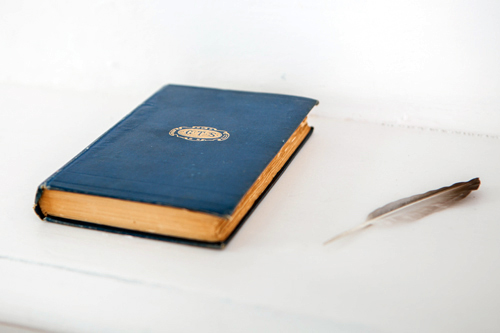 Fig. xvii The Republic of Plato & Seagull Feather Book by Davies, J. L. & Vaughan, D. J. (trans.) Macmillan, London, 1892 “These are the daughters of Necessity, the Fates, Lachesis, Clotho and Atropos; who, clothed in white robes, with garlands on their heads, chant to the music of the sirens, Lachesis the events of the past, Clotho those of the present, Atropos those of the future.” 617c  Fig. xviii HMS Iroquois, damage to OB plating I, II 1943 Digital reproductions of original archive print 241 x 162 mm Fig. xix F/S/M Minerve, damage by aircraft 14.10.43 I, II, III, IV 1943 Digital reproductions of original archive print 241 x 178 mm 
 Fig. xx Hurt books I, II, II 1888–1891, 1902–1903, 1913–1914 Cloth-bound accident book 370 x 250 mm x various widths 
 Fig. xxi Mess utensils – tin cups 1941 Measures - Spirit, Tin, Round, 1 pint, 1½ Gill & ½ Gill Various sizes 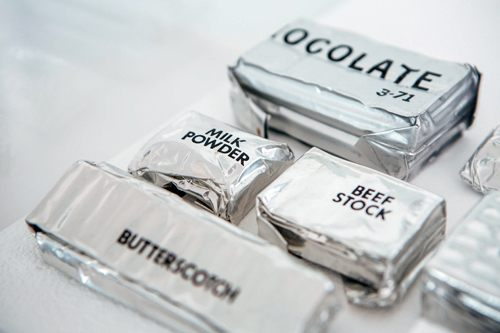 Fig. xxii Rations Believed to be 1971 but no accurate records Vacuum packed foodstuffs Various sizes  Fig. xxiii Lachesis (The Allotter) CNC milled aluminium sheet 765 x 355 x 10 mm |
 Fig. xxiv Hurt Book Digital print and various cuts, on Fabriana Liscia 160gsm and Revive Recycled Gloss 115gsm, stitch-bound Edition of 1 320 x 250 mm 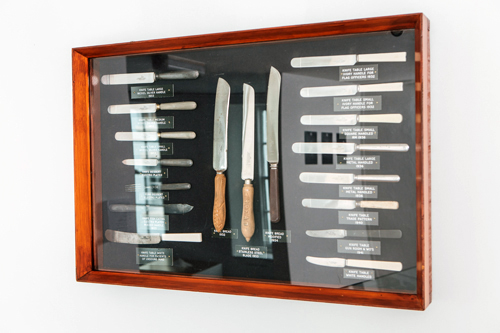
 Fig. xxv Knives 1930s-1950s Various sizes  Fig. xxvi Quercus Regius: 00:58-01:29 Digital film Black & white, 31 minute loop 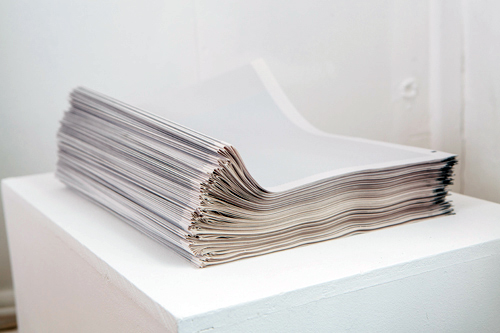 Fig. xxvii Belli Dura Despicio (Broadside) 29.7km line on 150 broadside sheets Digital print on 55 gsm newsprint 750 x 520 mm, folded to 375 x 260mm 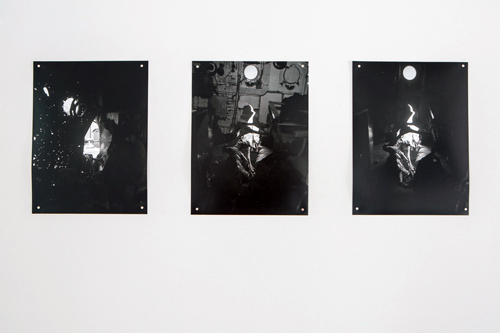 Fig. xxviii HMS Athabaskan (damage by glider bomb), I, II, III 1943 Digital prints from original glass negative 230 x 173 mm 
 Fig. xxix Shears, used for manually cutting metal Believed to be 1950s but no accurate records Steel 990 x 320 x 50mm "Comes the blind Fury with th'abhorred shears, / And slits the thin spun life." John Milton, Lycidas, l. 75  Fig. xxx Yard measure Date unknown Steel 914 x 90 x 5mm (approx) 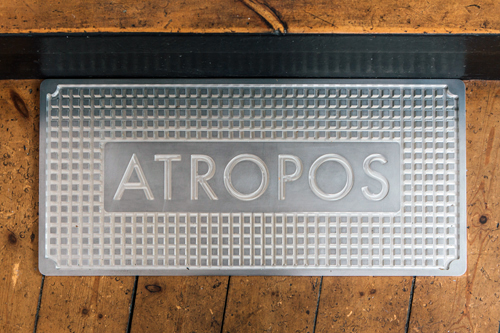 Fig. xxxi Atropos (The Unturning) CNC milled aluminium sheet 765 x 355 x 10mm |
Chapter 2: Plymouth Arts Centre
Chapter 2: Plymouth Arts Centre
Subscribe to:
Posts (Atom)